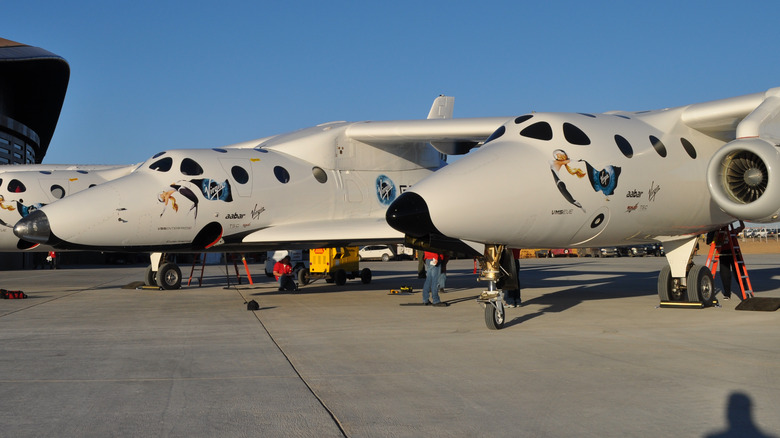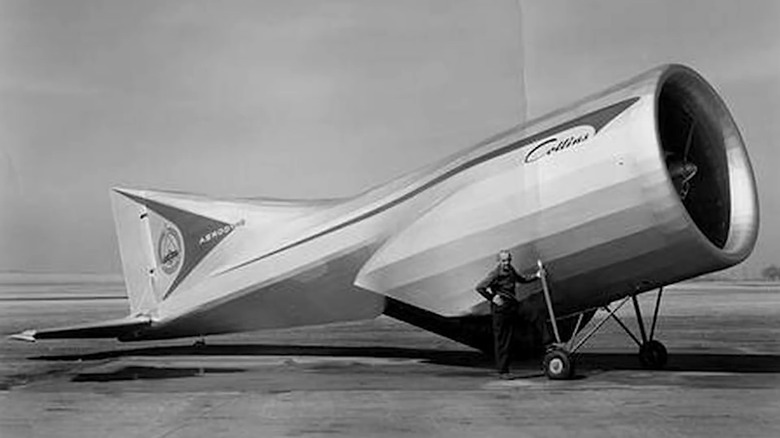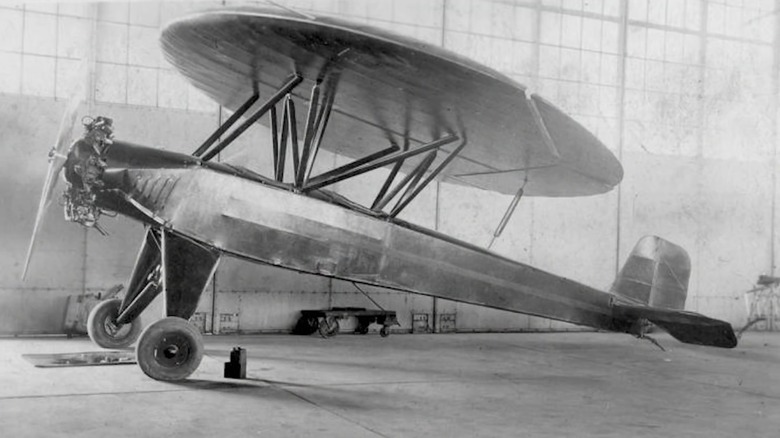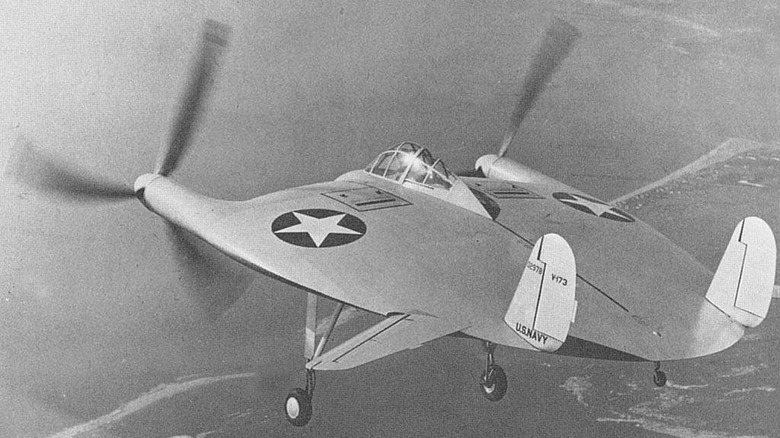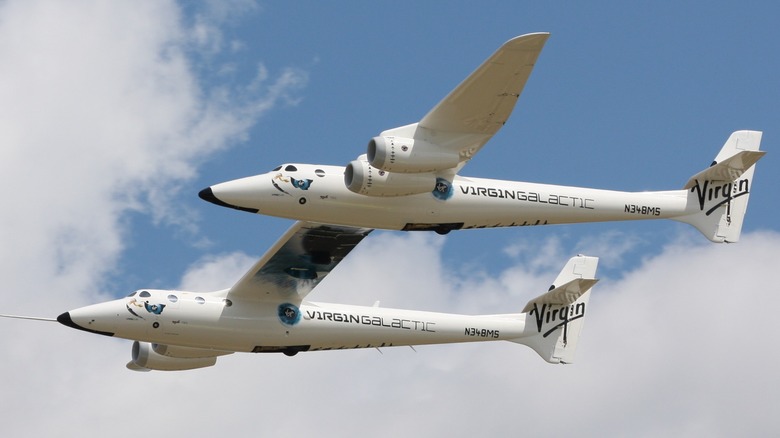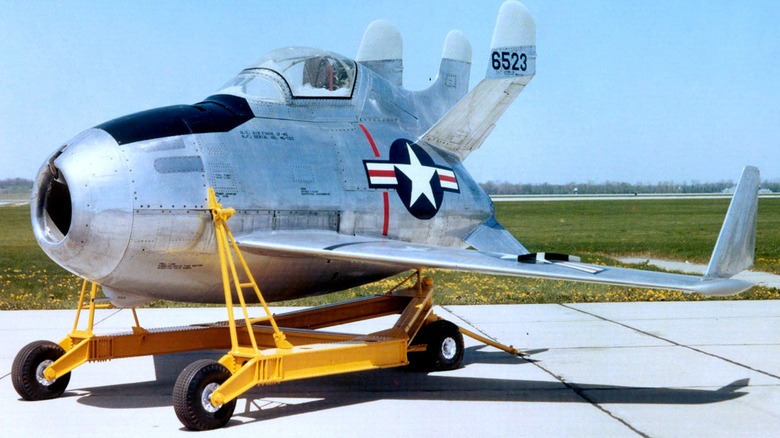5 Of The Strangest Aircraft Designs That Took To The Skies
On Dec. 17, 1903, the Wright brothers successfully flew the first powered aircraft at Kitty Hawk, North Carolina. That was a world-changing innovation that's been built upon ever since, and in the 120-plus years mankind has taken to the skies, thousands of airplane designs have been attempted. Of course, not every plane designed to fly actually does, and this was especially true in the beginning. It took a great deal of time and creativity for folks to come up with airplane designs that consistently worked.
Humanity went from wood and fabric to metal and composites, and as innovations in the industry spurred new waves of development, the propeller gave way to the jet engine. Along the way, numerous novel designs appeared, some looking so strange it defies logic that they could ever achieve powered flight. Still, some of them actually flew, though most didn't, while some that did never became standard.
These five aircraft are some of the strangest designs ever attempted, and despite their odd appearance and makeup, each successfully took to the skies, proving that flying aircraft don't necessarily have to always look and act the same.
Alexander Lippisch's Aerodyne
When people think of unmanned aerial vehicles, they likely picture the MQ-1 Predator drone or any of the many drones used today. But the idea of remotely operating an aircraft goes back quite a bit, with the first successful test occurring in 1917. The technology has improved significantly since that time, and in 1972, Alexander Lippisch put together a unmanned aerial vehicle of his own called the Aerodyne.
Aircraft designs, from passenger planes to fighter jets, are usually pretty standard, but that's not true of this unusual design. The Aerodyne was a vertical takeoff and landing craft with no wings but a prominent tail, enabling it to pitch and yaw. Its most prominent feature is its comparatively massive jet engine, which is on display at the Deutsches Museum Flugwerft Schleissheim in Oberschleissheim, just outside of Munich, Germany. The Aerodyne was operated remotely via radio, and a successful test in September 1972 proved its viability.
Had it been adopted, the Aerodyne would have functioned as both a land and ship-based aircraft designed for aerial reconnaissance. But the West German government lost interest, which halted development.
Still, it was an intriguing and ingenious design. Lippisch built his Aerodyne around the principles of lift and thrust via a single flow channel. Flaps directed airflow for steering, and it could hover as well as flying. It's certainly strange, but you can't argue with the results.
Nemeth Parasol
Pretty much all airplanes with wings boast a familiar shape, but the Nemeth Parasol is different. Designed in the early 1930s, it has a fuselage, engine, landing gear, tail, and other aspects much like other aircraft built around the same time — but unlike most of them, the Nemeth Parasol has a single wing with a distinctive circular shape.
There's a reason for this, and it's actually quite practical. The plane was designed for two purposes: to ensure it would be easy to store, and easy to fly and learn how to fly. The fuselage came from a lengthened Alliance A-1 Argo, but the wing was built by students at Miami University of Ohio. The concept of the so-called "roundwing," which had a diameter of 15 feet, was to function as a parachute. Should the need arise, the engine could be shut off, and the plane would slowly fall back to Earth.
The aircraft's designer, Steven Nemeth of Dayton, Ohio, tested the Parasol for two years, trying out different engines and speeds to ensure the parachute function's viability. The plane flew well enough, with a successful test flight in 1934, and its wing functioned as designed, but there wasn't any commercial interest in developing it further. The fate of the single Nemeth Parasol ever built remains unknown, though it was likely destroyed for parts, as it was ultimately little more than a curiosity.
Vought V-173 Flying Pancake
While most modern aircraft feature a two-winged design that enables lift, that's not the only way to design a plane. Northrop Grumman's B-2 Spirit and B-21 Raider are examples of flying-wing designs, and they weren't new when those strategic bombers were created. People had toyed with the concept of an all-wing aircraft since the 1920s, though development didn't begin in earnest until World War II. Both Axis and Allied powers worked to design a flying-wing aircraft without a discernible fuselage.
One successful design was the Vought V-173, known as the "Flying Pancake" by anyone who caught a glimpse of it. The Vought V-173 entered development in the early 1940s and took its first flight in November 1942. The design worked, but it came with some issues. The aircraft utilized two 80-hp Continental A-80 engines, each powering a single propeller. The Vought V-173's gearbox was problematic, and other concerns made it impractical to take part in the ongoing conflict. The Vought V-173 took its final flight in March 1947 before the project was canceled.
While not a true VTOL aircraft, the Vought V-173 proved in more than 130 hours of flight operations that it was capable of near-vertical takeoff and landing. The lessons learned from the proof-of-concept Vought V-173 helped in the design of subsequent flying-wing aircraft, ultimately leading to those B-2 and B-21 strategic bombers.
[Featured image by Unknown via Wikimedia Commons | Cropped and scaled | Public Domain]
Scaled Composites WhiteKnightTwo
Many aviation concepts came and went decades ago, leaving the world with a mostly standard type of aircraft. But people still innovate and create new planes, whether to prove a concept viable or to suit a specific purpose. The latter is true of a recent aircraft, the Scaled Composites Model 348 WhiteKnightTwo. This unusual-looking plane boasts a quadjet design and its purpose is to launch Virgin Galactic's SpaceShipTwo from the ground, where it could be released at the appropriate altitude.
WhiteKnightTwo is large, boasting nearly an 80-foot wingspan. It's fitted with four Pratt & Whitney Canada PW308 engines, each of which provides 8,350 pound-feet of thrust. This aircraft must fly high to unleash its payloads, which it originally did at about 44,500 feet, or 8.4 miles. Then SpaceShipTwo drops from its center cargo position, ignites its rocket and soars to an altitude of as high as 50 miles.
Virgin Galactic founder Richard Branson named the first WhiteKnightTwo VMS Eve, after his mother. While only one WhiteKnightTwo has been built, in 2008, it has been heavily upgraded in an overhaul that lasted from October 2021 until February 2023, and it can now release SpaceShipTwo at between 47,000 and 50,000 feet. Another WhiteKnightTwo was planned, the VMS Spirit of Steve Fossett, but it hasn't been constructed as of 2024.
[Featured image by D. Miller via Wikimedia Commons | Cropped and scaled | CC BY 2.0]
McDonnell XF-85 Goblin
McDonnell Aircraft's XF-85 Goblin was a parasitic fighter designed to fit into and launch from the bomb bay of the Convair B-36 bomber. The XF-85 entered development as a way of extending the relatively short range of interceptor aircraft back in the early 1940s. The problem was that most fighters couldn't keep pace to protect bombers.
The XF-85 would have mitigated this problem by launching from bombers already in flight, making the Convair B-36 a sort of airborne aircraft carrier. The result was one of the oddest-looking fighter jets ever constructed.
Only two were made and the project was ultimately canceled, but it wasn't for a lack of airworthiness. The XF-85 had a wingspan of just over 21 feet and a length just shy of 15 feet, with a height of 8 feet 3 inches. It boasted a Westinghouse J34-WE-7 turbojet engine that provided 3,000 pounds of thrust. This gave it a maximum speed of 664 mph, though its cruising speed was 225 mph.
While the XF-85 flew just fine and launched as planned, it couldn't return to the bomber due to the conflicting and turbulent air cushion between the two aircraft. As a result, it wasn't practical for what it was designed to do, and the U.S. Air Force abandoned the project in 1949 in favor of burgeoning air refueling technology.
[Featured image by U.S. Air Force via Wikimedia Commons | Cropped and scaled | Public Domain]
